fog lights KIA FORTE 2020 Owners Manual
[x] Cancel search | Manufacturer: KIA, Model Year: 2020, Model line: FORTE, Model: KIA FORTE 2020Pages: 568, PDF Size: 8.58 MB
Page 177 of 568
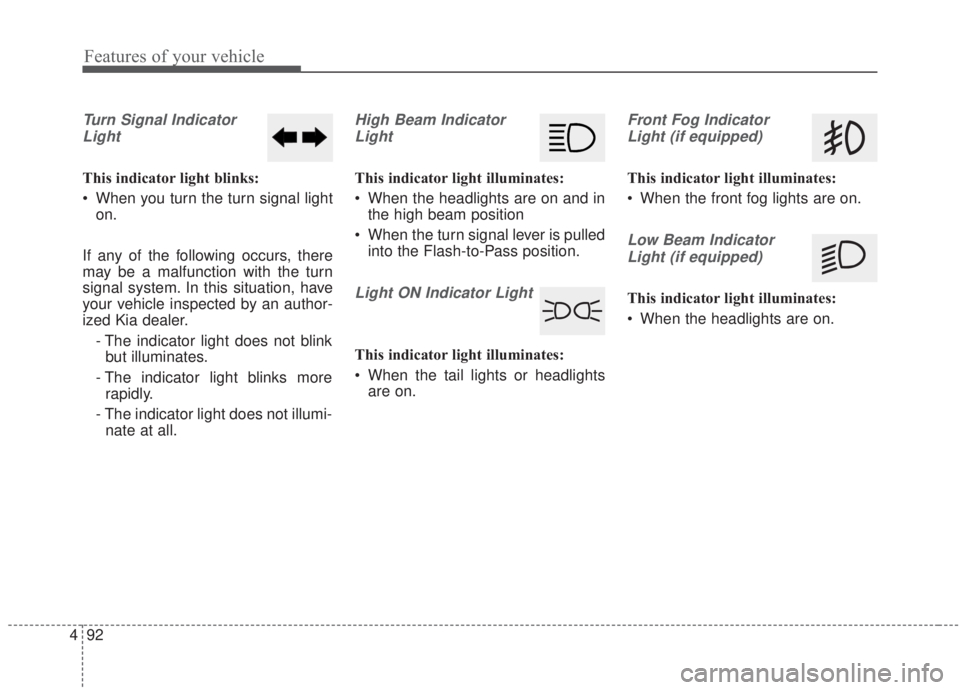
Features of your vehicle
92
4
Turn Signal Indicator
Light
This indicator light blinks:
When you turn the turn signal light on.
If any of the following occurs, there
may be a malfunction with the turn
signal system. In this situation, have
your vehicle inspected by an author-
ized Kia dealer. - The indicator light does not blinkbut illuminates.
- The indicator light blinks more rapidly.
- The indicator light does not illumi- nate at all.
High Beam Indicator
Light
This indicator light illuminates:
When the headlights are on and in the high beam position
When the turn signal lever is pulled into the Flash-to-Pass position.
Light ON Indicator Light
This indicator light illuminates:
When the tail lights or headlightsare on.
Front Fog Indicator
Light (if equipped)
This indicator light illuminates:
When the front fog lights are on.
Low Beam IndicatorLight (if equipped)
This indicator light illuminates:
When the headlights are on.
Page 185 of 568
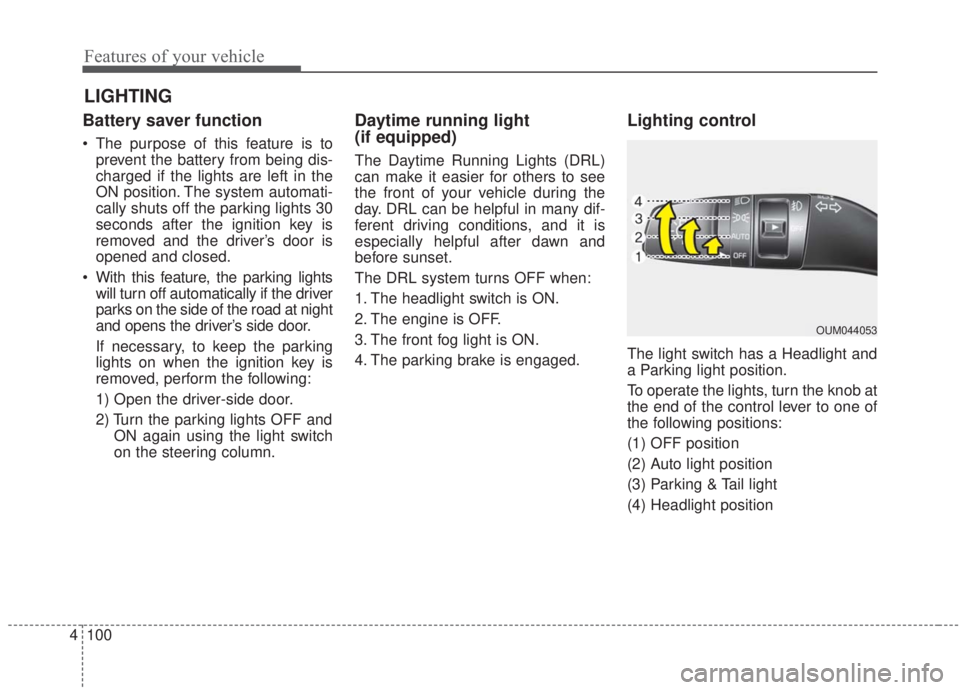
Features of your vehicle
100
4
Battery saver function
The purpose of this feature is to
prevent the battery from being dis-
charged if the lights are left in the
ON position. The system automati-
cally shuts off the parking lights 30
seconds after the ignition key is
removed and the driver’s door is
opened and closed.
With this feature, the parking lights will turn off automatically if the driver
parks on the side of the road at night
and opens the driver’s side door.
If necessary, to keep the parking
lights on when the ignition key is
removed, perform the following:
1) Open the driver-side door.
2) Turn the parking lights OFF and ON again using the light switch
on the steering column.
Daytime running light
(if equipped)
The Daytime Running Lights (DRL)
can make it easier for others to see
the front of your vehicle during the
day. DRL can be helpful in many dif-
ferent driving conditions, and it is
especially helpful after dawn and
before sunset.
The DRL system turns OFF when:
1. The headlight switch is ON.
2. The engine is OFF.
3. The front fog light is ON.
4. The parking brake is engaged.
Lighting control
The light switch has a Headlight and
a Parking light position.
To operate the lights, turn the knob at
the end of the control lever to one of
the following positions:
(1) OFF position
(2) Auto light position
(3) Parking & Tail light
(4) Headlight position
LIGHTING
OUM044053
Page 192 of 568
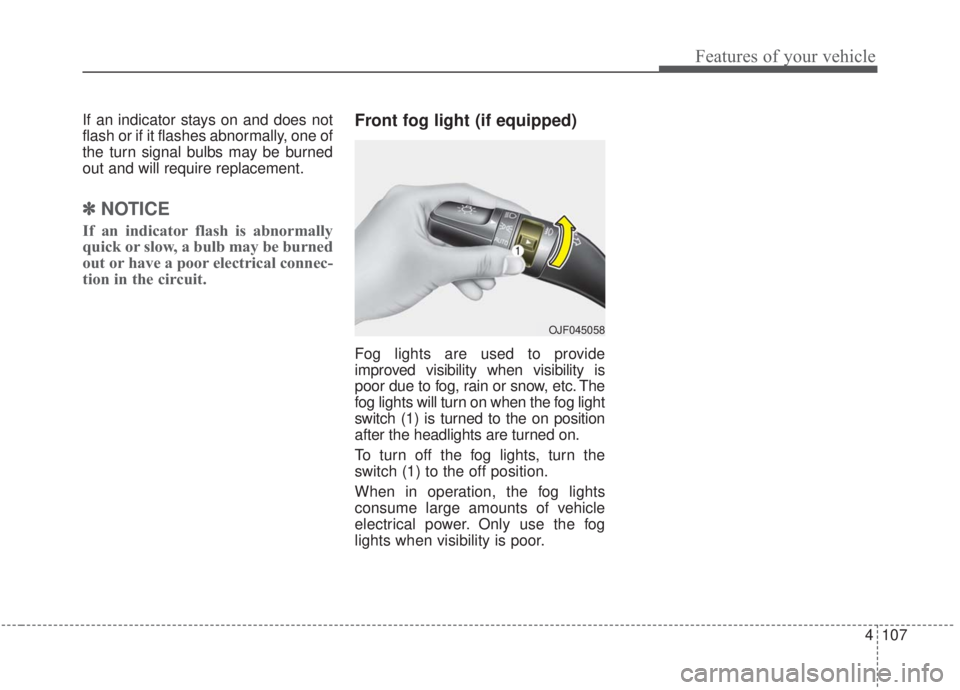
4107
Features of your vehicle
If an indicator stays on and does not
flash or if it flashes abnormally, one of
the turn signal bulbs may be burned
out and will require replacement.
✽ ✽NOTICE
If an indicator flash is abnormally
quick or slow, a bulb may be burned
out or have a poor electrical connec-
tion in the circuit.
Front fog light (if equipped)
Fog lights are used to provide
improved visibility when visibility is
poor due to fog, rain or snow, etc. The
fog lights will turn on when the fog light
switch (1) is turned to the on position
after the headlights are turned on.
To turn off the fog lights, turn the
switch (1) to the off position.
When in operation, the fog lights
consume large amounts of vehicle
electrical power. Only use the fog
lights when visibility is poor.
OJF045058
Page 314 of 568
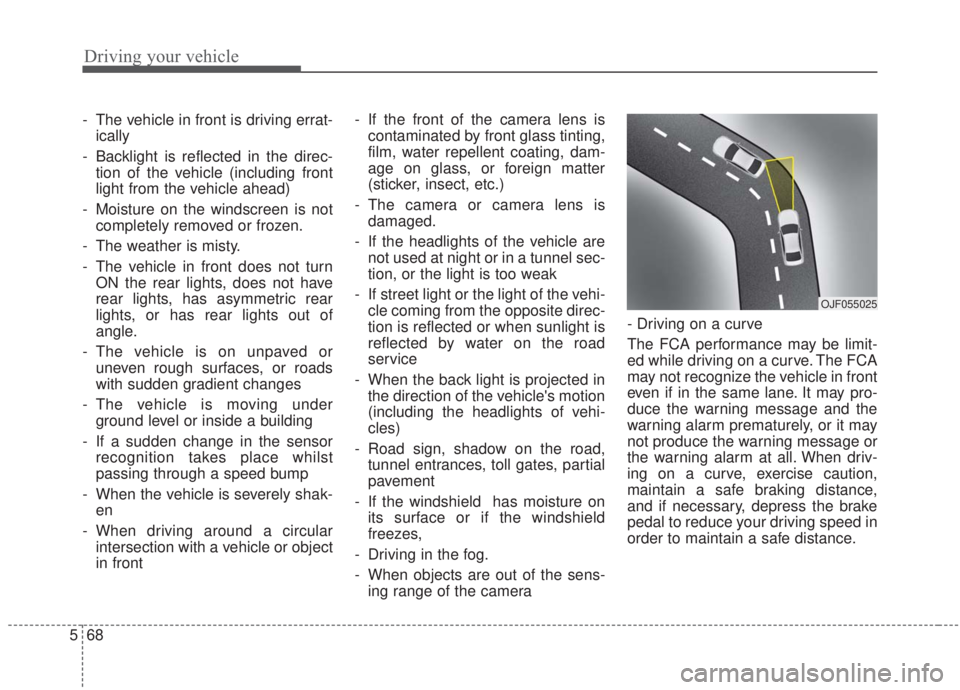
Driving your vehicle
68
5
- The vehicle in front is driving errat-
ically
- Backlight is reflected in the direc- tion of the vehicle (including front
light from the vehicle ahead)
- Moisture on the windscreen is not completely removed or frozen.
- The weather is misty.
- The vehicle in front does not turn ON the rear lights, does not have
rear lights, has asymmetric rear
lights, or has rear lights out of
angle.
- The vehicle is on unpaved or uneven rough surfaces, or roads
with sudden gradient changes
- The vehicle is moving under ground level or inside a building
- If a sudden change in the sensor recognition takes place whilst
passing through a speed bump
- When the vehicle is severely shak- en
- When driving around a circular intersection with a vehicle or object
in front - If the front of the camera lens is
contaminated by front glass tinting,
film, water repellent coating, dam-
age on glass, or foreign matter
(sticker, insect, etc.)
- The camera or camera lens is damaged.
- If the headlights of the vehicle are not used at night or in a tunnel sec-
tion, or the light is too weak
- If street light or the light of the vehi- cle coming from the opposite direc-
tion is reflected or when sunlight is
reflected by water on the road
service
- When the back light is projected in the direction of the vehicle's motion
(including the headlights of vehi-
cles)
- Road sign, shadow on the road, tunnel entrances, toll gates, partial
pavement
- If the windshield has moisture on its surface or if the windshield
freezes,
- Driving in the fog.
- When objects are out of the sens- ing range of the camera - Driving on a curve
The FCA performance may be limit-
ed while driving on a curve. The FCA
may not recognize the vehicle in front
even if in the same lane. It may pro-
duce the warning message and the
warning alarm prematurely, or it may
not produce the warning message or
the warning alarm at all. When driv-
ing on a curve, exercise caution,
maintain a safe braking distance,
and if necessary, depress the brake
pedal to reduce your driving speed in
order to maintain a safe distance.
OJF055025
Page 330 of 568
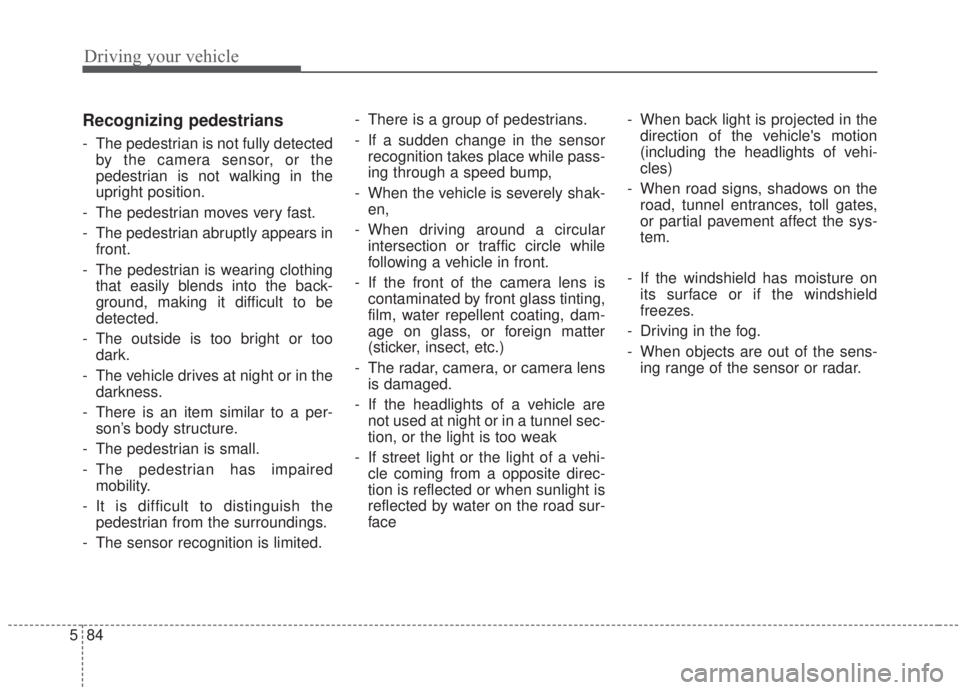
Driving your vehicle
84
5
Recognizing pedestrians
- The pedestrian is not fully detected
by the camera sensor, or the
pedestrian is not walking in the
upright position.
- The pedestrian moves very fast.
- The pedestrian abruptly appears in front.
- The pedestrian is wearing clothing that easily blends into the back-
ground, making it difficult to be
detected.
- The outside is too bright or too dark.
- The vehicle drives at night or in the darkness.
- There is an item similar to a per- son’s body structure.
- The pedestrian is small.
- The pedestrian has impaired mobility.
- It is difficult to distinguish the pedestrian from the surroundings.
- The sensor recognition is limited. - There is a group of pedestrians.
- If a sudden change in the sensor
recognition takes place while pass-
ing through a speed bump,
- When the vehicle is severely shak- en,
- When driving around a circular intersection or traffic circle while
following a vehicle in front.
- If the front of the camera lens is contaminated by front glass tinting,
film, water repellent coating, dam-
age on glass, or foreign matter
(sticker, insect, etc.)
- The radar, camera, or camera lens is damaged.
- If the headlights of a vehicle are not used at night or in a tunnel sec-
tion, or the light is too weak
- If street light or the light of a vehi- cle coming from a opposite direc-
tion is reflected or when sunlight is
reflected by water on the road sur-
face - When back light is projected in the
direction of the vehicle's motion
(including the headlights of vehi-
cles)
- When road signs, shadows on the road, tunnel entrances, toll gates,
or partial pavement affect the sys-
tem.
- If the windshield has moisture on its surface or if the windshield
freezes.
- Driving in the fog.
- When objects are out of the sens- ing range of the sensor or radar.
Page 501 of 568

Maintenance
64
7
3. Pull the suspected fuse straight
out. Use the removal tool provided
on the engine compartment fuse
panel cover.
4. Check the removed fuse; replace it if it is blown.
Spare fuses are provided in theengine compartment fuse panel.
5. Push in a new fuse of the same rating, and make sure it fits tightly
in the clips.
If it fits loosely, consult an authorized
Kia dealer.
If you do not have a spare, use a fuse of the same rating from a circuityou may not need for operating thevehicle, such as the power outletfuse.
If the head lamp, turn signal lamp,
stop signal lamp, fog lamp, Daytime
Running Lights (DRL), tail lamp,
High mounted stop lamp (HMSL) do
not work and the fuses are OK,
check the fuse panel in the engine
compartment. If a fuse is blown, it
must be replaced.
✽ ✽ NOTICE
If the headlamp, fog lamp, turn sig-
nal lamp, or tail lamp malfunction
even without any problem to the
lamps, have the vehicle checked by
an authorized Kia dealer for assis-
tance.
Engine compartment fuse
replacement
1. Turn the ignition switch and all
other switches off.
2. Remove the fuse panel cover by pressing the tab and pulling the
cover up.
OBD078018
OBD078019
Page 514 of 568

777
Maintenance
LIGHT BULBS
Bulb replacement precaution
Please keep extra bulbs on hand
with appropriate wattage ratings in
case of emergencies.
Refer to the "Bulb Wattage" section
in Chapter 8.
When changing lamps, first turn off
the engine at a safe place, firmly
apply the parking brake and detach
the battery’s negative (-) terminal.
net-work failure
The headlamp, taillight, and fog light
may light up when the head lamp
switch is turned ON, and not light up
when the taillight or for light switch is
turned ON. This may be cause by
network failure or vehicle electrical
control system malfunction. If there is
a problem, we recommend the sys-
tem be serviced by an authorized Kia
dealer.
trical control system stabilization
A normally functioning lamp may
flicker momentarily. This momentary
occurrence is due to the stabilization
function of the vehicle's electrical
control system. If the lamp stops
flickering after a few moments, the
vehicle does not require service.
However, if the lamp goes out after
the momentary flickering, or the flick-
ering continues, we recommend the
system be serviced by an authorized
Kia dealer.
WARNING- Working on the lights
Prior to working on the light,
firmly apply the parking brake,
ensure that the ignition switch
is turned to the LOCK position
and turn off the lights to avoid
sudden movement of the vehi-
cle, burns to your skin for fin-
gers, or an electric shock.
CAUTION -Light replace-
ment
Be sure to replace the burned- out bulb with one of the samewattage rating. Otherwise, itmay cause damage to the fuseor electric wiring system.
CAUTION -Headlamp
Lens
To prevent damage, do notclean the headlamp lens withchemical solvents or strongdetergents.
Page 563 of 568
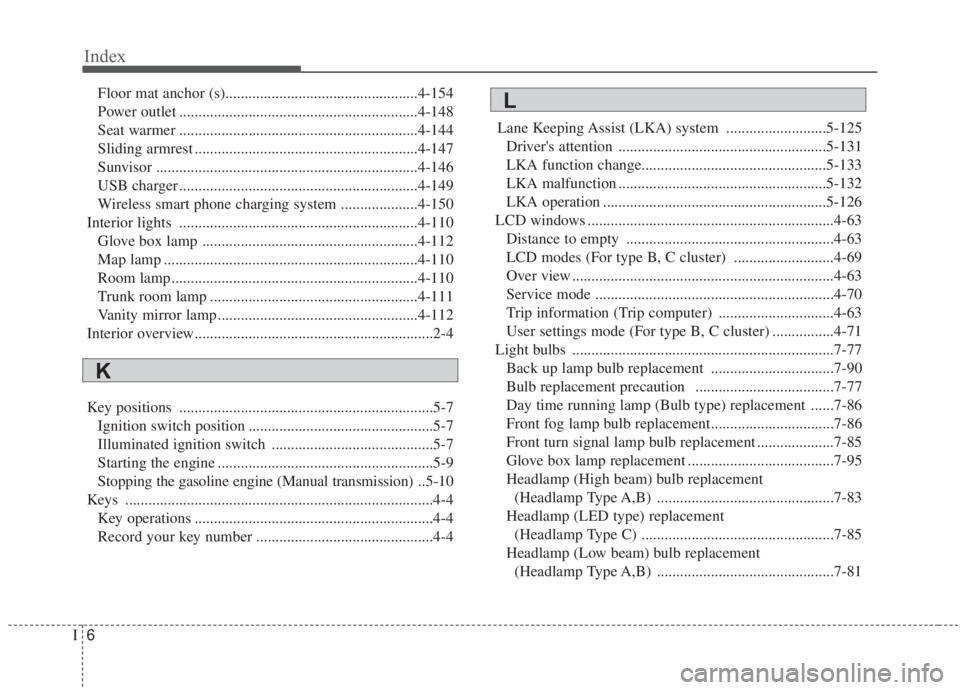
Index
6I
Floor mat anchor (s)..................................................\
4-154
Power outlet ..............................................................4-148
Seat warmer ..............................................................4-144
Sliding armrest ..........................................................4-147
Sunvisor ....................................................................4-14\
6
USB charger ..............................................................4-149
Wireless smart phone charging system ....................4-150
Interior lights ..............................................................4-110 Glove box lamp ........................................................4-112
Map lamp ..................................................................4-110
Room lamp ................................................................4-110
Trunk room lamp ......................................................4-111
Vanity mirror lamp ....................................................4-112
Interior overview..............................................................2-4
Key positions ..................................................................5-7 Ignition switch position ................................................5-7
Illuminated ignition switch ..........................................5-7
Starting the engine ........................................................5-9
Stopping the gasoline engine (Manual transmission) .. 5-10
Keys ........................................................................\
........4-4 Key operations ..............................................................4-4
Record your key number ..............................................4-4 Lane Keeping Assist (LKA) system ..........................5-125
Driver's attention ......................................................5-131
LKA function change................................................5-133\
LKA malfunction ......................................................5-132
LKA operation ..........................................................5-126
LCD windows ................................................................4-63 Distance to empty ......................................................4-63
LCD modes (For type B, C cluster) ..........................4-69
Over view ....................................................................4-63\
Service mode ..............................................................4-70
Trip information (Trip computer) ..............................4-63
User settings mode (For type B, C cluster) ................4-71
Light bulbs ....................................................................7-77\
Back up lamp bulb replacement ................................7-90
Bulb replacement precaution ....................................7-77
Day time running lamp (Bulb type) replacement ......7-86
Front fog lamp bulb replacement................................7-86
Front turn signal lamp bulb replacement ....................7-85
Glove box lamp replacement ......................................7-95
Headlamp (High beam) bulb replacement (Headlamp Type A,B) ..............................................7-83
Headlamp (LED type) replacement (Headlamp Type C) ..................................................7-85
Headlamp (Low beam) bulb replacement (Headlamp Type A,B) ..............................................7-81L
K
Page 567 of 568
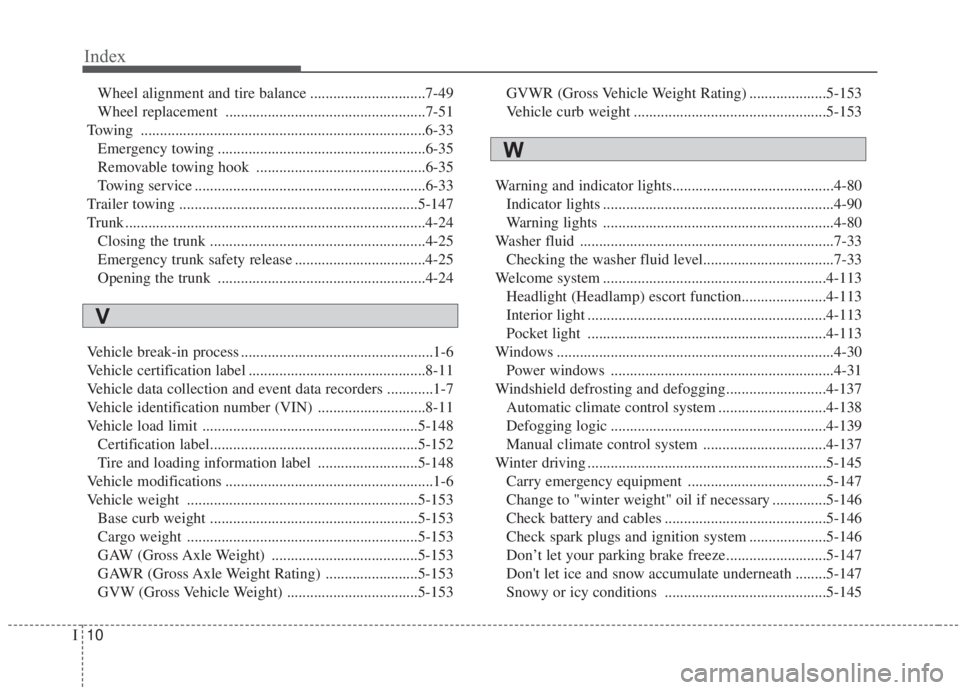
Index
10I
Wheel alignment and tire balance ..............................7-49
Wheel replacement ....................................................7-51
Towing ........................................................................\
..6-33 Emergency towing ......................................................6-35
Removable towing hook ............................................6-35
Towing service ............................................................6-33
Trailer towing ..............................................................5-147
Trunk ........................................................................\
......4-24 Closing the trunk ........................................................4-25
Emergency trunk safety release ..................................4-25
Opening the trunk ......................................................4-24
Vehicle break-in process ..................................................1-6
Vehicle certification label ..............................................8-11
Vehicle data collection and event data recorders ............1-7
Vehicle identification number (VIN) ............................8-11
Vehicle load limit ........................................................5-148 Certification label......................................................5-152
Tire and loading information label ..........................5-148
Vehicle modifications ......................................................1-6
Vehicle weight ............................................................5-153 Base curb weight ......................................................5-153
Cargo weight ............................................................5-153
GAW (Gross Axle Weight) ......................................5-153
GAWR (Gross Axle Weight Rating) ........................5-153
GVW (Gross Vehicle Weight) ..................................5-153 GVWR (Gross Vehicle Weight Rating) ....................5-153
Vehicle curb weight ..................................................5-153
Warning and indicator lights..........................................4-80 Indicator lights ............................................................4-90
Warning lights ............................................................4-80
Washer fluid ..................................................................7-33 Checking the washer fluid level..................................7-33
Welcome system ..........................................................4-113 Headlight (Headlamp) escort function......................4-113
Interior light ..............................................................4-113
Pocket light ..............................................................4-113
Windows ........................................................................\
4-30 Power windows ..........................................................4-31
Windshield defrosting and defogging..........................4-137 Automatic climate control system ............................4-138
Defogging logic ........................................................4-139
Manual climate control system ................................4-137
Winter driving ..............................................................5-145 Carry emergency equipment ....................................5-147
Change to "winter weight" oil if necessary ..............5-146
Check battery and cables ..........................................5-146
Check spark plugs and ignition system ....................5-146
Don’t let your parking brake freeze..........................5-147
Don't let ice and snow accumulate underneath ........5-147
Snowy or icy conditions ..........................................5-145
V
W